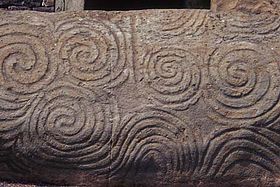This article needs additional citations for verification. (September 2007) |
Megalithic art refers to art either painted or carved onto megaliths in prehistoric Europe. Elizabeth Shee Twohig has coined the term Megalithic art in her study of 'The Megalithic Art of Western Europe'.[1] Her original definition of Megalithic art focused on paintings or carvings found on the structural elements, like the kerbstones, orthostats, or capstones of megalithic tombs, but recent investigations have included decorations on stelae and menhirs.
Megalithic art is found in many places in Western Europe although the main concentrations are in England, Malta, Ireland, Brittany and Iberia. Megalithic art started in the Neolithic and continued into the Bronze Age. Although many monument types received this form of art the majority is carved on Neolithic passage graves. Megalithic art tends to be highly abstract and contains relatively few representations of recognizable real objects. Megalithic art is often similar to prehistoric rock art and contains many similar motifs such as the 'cup and ring mark', although the two forms of rock carving also have large stylistic differences. The meaning of megalithic art is the subject of much debate.

Weathering and vandalism have affected many examples of the art, and little of it remains today.

- ^ Shee Twohig, E. 1981. Megalithic Art of Western Europe, Oxford: Clarendon Press.